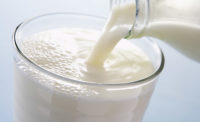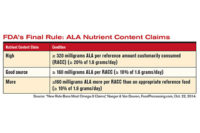Benefits of omega-3s are under scrutiny

Omega-3s are the most widely purchased nutritional supplement in the United States. But they took a dip in popularity in 2015 after several clinical trials failed to show a positive effect. A lower ratio of omega-6 to omega-3 fatty acids is desirable to reduce the risk of many chronic diseases of high prevalence in Western societies, but the typical American diet contains 14- to 25-times more omega-6s than omega-3s.
There is broad consensus that the optimal source of omega-3 fatty acids is fish and seafood, but not everyone likes the taste of fish. So fortified dairy products remain an important alternative source of essential fatty acids for babies and for consumers who prefer not to pop a pill or eat fatty fish.
Benefits under scrutiny
Reported benefits of omega-3s include reduced risk of acute coronary syndrome, better brain health, lower danger of heart failure, protection against stroke, lower triglycerides and reduced risk for dangerous heart arrhythmias. However, recent clinical trials and meta-analyses have shown conflicting results about the beneficial effect of omega-3s for cardiovascular disease. And results of a second phase of the large Age-Related Eye Disease Study (AREDS2) revealed that addition of omega-3s did not reduce macular degeneration and did not slow cognitive decline in older persons.
On a positive note, the new Multidomain Alzheimer’s Preventive Trial (MAPT) did show that omega-3 supplementation may help slow cognitive decline in older adults, especially those who have mild cognitive impairment. The AREDS2 researchers found some evidence that DHA could help clear the sticky plaques that are a hallmark of Alzheimer’s disease, and further research is warranted in that area. Other areas of exploration include joint health, inflammation, skin health, exercise recovery and other sports-related issues.
Infant formula and ‘growing-up’ milk
Most major brands of infant formula include DHA (an omega 3) and ARA (an omega-6).
“U.S. manufacturers added DHA and ARA to infant formulas well over a decade ago because it is best for babies,” said Mardi Mountford, executive vice president of the Infant Nutrition Council of America. “DHA and ARA are found in breast milk and it makes sense that they are in infant formulas as well. The industry has conducted more than 30 years of scientific research on these nutrients, and after reviewing more than 100 safety-related studies, including very extensive compositional analyses, the FDA determined that adding DHA to infant formulas is safe and granted GRAS status.”
One of the concerns about omega-3s from fish is that certain species of fish may contain high levels of mercury. The source of DHA and ARA in most infant formula brands is algae.
In the United States, mothers are advised to wean their babies to whole milk at one year of age. Horizon Organic offers the only major brand of whole milk fortified with DHA. In international markets, where fresh whole milk may not be as readily available, there is increased demand for growing-up milk for toddlers. These products are tailored to children’s stages of growth and are often fortified with DHA to support brain function.
Other dairy opportunities
Horizon Organic also offers various fat-free and low-fat milks fortified with DHA. Smart Balance, another major brand fortified with omega-3s, includes various milk and fortified spreads. Other fortified dairy categories include butters, yogurts (including infant yogurt), baby cheese, smoothies and puddings.
“Algal oils and fish oils both are easily incorporated into milks as long as a small portion of milk is pre-emulsified with the oil and sometimes an additional antioxidant (ascorbate and/or tocopherol),” said Diane Hnat, the senior technical marketing manager for DSM Nutritional Products. “It is possible to add omega-3 powders to milk depending on the processing line or other constraints of adding oils. Oils would be the preferred form added to yogurts, kefir, butter, margarines and cheeses.”
Excessive heat, light, and oxygen can initiate oxidation of omega-3s, which can have negative effects on both flavor and nutritional value. Strategies to block light include using foil-lined pouches and cardboard. Dairy processors can utilize foil-lined pouches, PET bottles, multilayer cartons and flushing the headspace with nitrogen to keep out oxygen.
New regs take effect in 2016
New FDA regulations went into effect in January. Product manufacturers can still make a factual statement about the level of omega-3s in their products, but nutrient content claims, such as “good” or “excellent” source of EPA and DHA, can no longer be made. The only essential fatty acid for which there is an established value, and nutrient content claims are allowed, is ALA.
As new benefit areas for omega-3s are explored, dairy will continue to provide a tasty way to consume these essential nutrients.
Looking for a reprint of this article?
From high-res PDFs to custom plaques, order your copy today!









